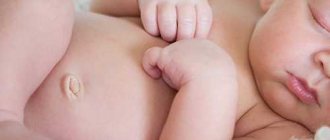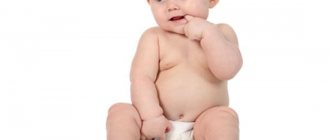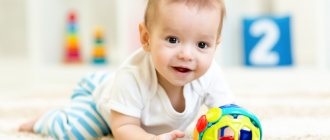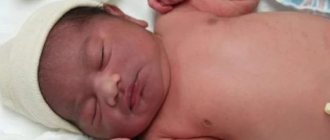Baby 1 month: new world, new schedule
In just twelve months, your baby will change beyond recognition, and not only in appearance.
He will turn into an active and curious toddler, already beginning to walk, talk and show the first signs of character. But this “ascent” has 12 steps, 12 months. The first stage - the starting stage - consists mainly of the baby’s adaptation to the new conditions of “being”. But this does not mean that a 1-month-old baby has absolutely nothing to brag about! A child's development in the first month of life really boils down to the fact that he is getting used to a new, big, strange world.
And you get used to the fact that from now on you must constantly and inseparably be near him and take care of him.
Bathing a baby at 2 months
By 2 months, parents gain confidence and skill in bathing their baby. At this age, they usually switch to swimming every other day and preferably in the evening - from 19.30 to 21.00. For better sleep for the baby, add a decoction of chamomile, oak bark, lavender or string to the water. The water temperature should be at least 36-37ºС , and in the bathroom the temperature should be maintained at least 23-24ºС.
By this age, the child is already accustomed to the bathing procedure. And most children really enjoy this process. If before this the child bathed in a small bath, then at 2 months you can arrange water procedures in a large bath. For this, the child is bought a special inflatable ring, which is fixed around the neck. Thanks to him, the baby is able to move around the bathtub, pushing off with his hands and feet from its sides.
Child development in the first month of life: losing weight, gaining weight
There is no need to worry if your baby loses a little weight in the first days of life. Newborns are born with extra fluid in their bodies and typically lose up to 10% of their body weight in the first week. After this, their body stabilizes, and the child begins to gain weight again. At the end of the second week, babies usually weigh about the same as they weighed at birth.
But by the end of the first month of life, children, in conditions of adequate care and diet, begin to rapidly and steadily gain weight - on average from 15 to 30 grams every day.
Baby's vision at 2 months
At two months, the child’s hearing and vision improve. Lying on his tummy, your baby can make smooth tracking movements with his eyes, which are different from the jerky eye movements in the first month of birth. The child calmly tracks a bright object that moves at a distance of up to 60 centimeters and watches a vertically moving object.
At two months, the child is able to focus his gaze on objects. His special attention is attracted either by bright and colorful objects, or by objects that he sees for the first time in his life. He can look at such objects for several minutes.
Children's visual perception at this age becomes clearer; they are able to see the outlines of objects and their colors. If you start playing with a rattle with your baby, slowly moving it in different directions, he will begin to follow it, trying not to look away. Now the baby can distinguish the closest people - mom and dad - from all strangers. He also begins to distinguish living objects from nonliving ones. For example, a baby watches a cat with more interest than a toy.
If, when moving, the handles come into the field of view, he concentrates his gaze on them. Flashes if an object is brought close to his face.
At this age, the mucous membrane of the eye is not yet very sensitive, so specks that get into the eye rarely bother the baby, this also applies to the situation when he gets his finger in the eye. Poor co-coordination of the eyeballs may also be observed, which results in slight squint.
At two months, the baby is able to distinguish its mother from other adults, remembers and recognizes her face and smell. He becomes more sociable. Communication skills begin to develop.
What a 1 month old baby can do: touching reflexes
Despite the fact that in the first month of a child’s life his nervous system is still in the process of development, he already knows a lot. You will see that your baby has several innate reflexes. One of these, for example, is sucking. Soon after birth, your baby will be able to latch and eat, albeit with your help. And if you touch his palm or place your finger on it, he will involuntarily clench it into a fist.
This reflex has made more than one generation of fathers happy. It’s a rare dad who will miss an opportunity to touchingly boast that his offspring has a strong man’s handshake or an “iron” grip.
If the baby is suddenly frightened by something, for example, a flash of bright light, he spreads his arms and legs to the sides, and then presses them back. This is called the Moro reflex, it will remain in the child until the 4-5th month, then it will gradually begin to fade away.
Fourth month
If we consider the development of a child up to one year old by month, then the fourth month is considered to consolidate what the baby mastered during the third. Now he can confidently hold his head, begins to sit with support, and masters the sitting position with support. May respond to the pronunciation of his name, the sound of music, loud laughter or crying. Weight gain is about 700 grams, height gain is 2-3 cm.
During this period, it is extremely important to develop the emotional sphere of the baby. It is necessary to show him grimaces, pictures, and talk more with a varied intonation.
Read more in the article Baby development in the fourth month of life
The child is 1 month old: “I would take it and go - let them let me go!”
By the end of the first month of life, your baby will already have developed the instinct to walk. If you hold your baby and place his foot on a flat, hard surface, he will try to take his first steps. This reflex is called the automatic newborn gait. But don't rush! There is a time for everything - there is no need to try to place the child on the floor or table, supporting him only by the arms. The baby's spine is still too weak and definitely not ready for such a load.
In addition, although a one-month-old newborn is already able to turn his head when lying on his stomach, his neck is not yet strong enough for him to support his head on his own. Therefore, always support the back of your baby's head when picking him up.
Important reflexes
Nature has endowed the newborn with unconditioned reflexes so that he can adapt to the world around him and prepare for conscious movements. Their assessment should be carried out in a warm room, on a flat surface. At the same time, the baby should not be tired, hungry or wet. A child with a healthy nervous system should have the following reflexes in the first month of life:
- Sucking. If any object (pacifier, nipple) gets into the baby's oral cavity, he will begin to make rhythmic sucking movements. A full-term baby is born with this important reflex and retains it throughout the first year of life.
- Search. If you gently touch the corner of the baby's mouth, he will lower his lower lip and actively seek the mother's breast. At the same time, touching the baby’s mouth more roughly can cause a different reaction: the child will feel irritated and turn his head in the opposite direction.
- Palmo-oral. If you apply moderate pressure to the baby's palm, he will open his mouth and tilt his head forward.
- Prehensile. The baby grasps and firmly holds the adult’s fingers placed in his palm.
- Protective. When placed on the stomach, the baby immediately turns his head to the side. This reflex allows the baby to breathe in this position. This is why a healthy baby will not suffocate while sleeping on his tummy.
- Crawling. If you lay the baby on his stomach and touch his feet, he will try to push off from the adult’s palms.
- Automatic walking. If you give the child a vertical position so that he “leans” his legs on a hard surface, and tilts him forward a little, the baby will begin to “walk.”
Babies in the first month of life love to sleep on their backs in the frog position and can already wake up from sharp sounds
Sleeping like a baby?
For the first few weeks, it may seem to you that the only thing a newborn needs besides his mother’s breast is a sound, healthy and long sleep. In fact, newborns actually sleep a lot, 15-16 hours a day. These hours may be irregular because the child is not yet accustomed to the normal day and night cycle.
Remember, in the first month of your baby's life, his sleep and wake cycles are very different from yours. Unlike adults, infants' sleep mostly consists of REM sleep. This means that during the first weeks, your baby will wake up as unexpectedly as he falls asleep.
You can help your baby acclimate to natural rhythms more quickly by playing and talking to him during the day, and keeping things monotonous and boring at night. Eventually, the baby will “understand” that they play during the day and sleep at night. And gradually, just towards the end of the first month of life, the baby will become more and more awake during the day and sleep more soundly at night.
How do the senses work in a newborn?
How does a 1 month old baby see?
By the first month of life, the eyeball already has formed qualities. However, the visual function has not yet reached its full development. The baby's tears begin to form only in the third or fourth week. Most children at this age are characterized by slight wobble of the eyeball and slight squint. There is no need to worry too much about this; this phenomenon is due to the incomplete development of visual function and will soon pass.
Parents ask: when does the child begin to see? A newborn sees objects as blurry and indistinct. A one-month-old baby can clearly distinguish objects located at a distance of about 60 cm from his eyes. It is at this distance that he clearly sees the face of mom or dad, recognizes them, begins to react with facial expressions and try to make sounds. He will also notice the bright toys that hang in his crib.
A newborn baby begins to see and recognize the face of mom or dad at 1 month at a distance of 60 cm from his eyes
The baby needs to be helped to develop his vision. To do this, you need to take the child in your arms more often or lean over him so that he can clearly see the faces of his parents, examine and remember individual facial features. Don't be lazy to play with him, showing him colored rattles.
By the end of the first month of his life, the baby can already follow with his eyes a slowly moving toy near his face. These are his very first games.
Just don’t tire your baby, spend a few minutes a day on such games, for his age this is quite enough.
Exercises for developing vision:
- Sew a rubber band onto a small toy and hang it over your baby. Make the toy “jump” up and down in front of the child. Very soon the baby will not only look at the jumping toy, but also try to grab it with his hands.
- Place a bright towel on your shoulder while feeding; your baby will look from your face to this bright object.
- To better focus your gaze , do the following: show your baby a large toy at a distance of 25 - 30 cm , wait for the baby to fix his gaze on it, and slowly move the toy to the side. Try to keep your baby's gaze focused on the object. You can smoothly move the toy, first horizontally, then vertically, and finally in a circle.
- The same exercise can be done with a rattle, additionally making soft sounds. Do the exercise 1-2 times a day for 2 minutes per session.
How do newborns hear at 1 month?
The first few weeks of a baby's life are filled with completely new sounds. Since the newborn has not yet learned to detect the location where the sound is coming from, his natural reaction will be to freeze. However, when the child suddenly hears the parent's voice, he immediately stops crying.
At one month of age, the baby can already distinguish sounds well and turns his head towards the sound source. Try rattling a rattle to the side - the baby will definitely turn his head in that direction. Babies of this age love quiet, pleasant sounds, but their favorite, of course, is their mother’s voice. The child reacts especially actively to the mother’s voice and is able to feel her mood by timbre. If the mother speaks affectionately and calmly, the baby really likes it, he expresses his emotions with active movements of his legs and arms, and various sounds.
At the age of 1 month, you can see the baby's first smile. More often it is addressed to the mother as the most beloved person. If the mother is irritated or offended, the baby also feels her emotional state and may cry or be capricious.
A baby's hearing needs to be developed and trained. To do this, you need to talk to your baby more often, sing songs to him, and read books. Be sure to involve all family members. It's good if the baby has older brothers and sisters. Communication with them should occur from the very first days of life. Turn on low and calm music and keep the TV on during the day. The newborn should get used to different sounds, just avoid sounds that are too loud and unpleasant so as not to frighten him.
Exercises for hearing development:
You can play classical music or recordings of various musical instruments for your newborn for up to 10 minutes every day.
- Place a “mobile” with 3-4 large toys and a pleasant melody in your child’s crib. Periodically place your baby on a development mat.
- Talk to your baby more often and try to let the baby see your facial expressions - this will stimulate the child’s hearing and speech development. The baby will quickly begin to respond with a conscious smile in response to the mother’s affectionate speech.
- Start reading children's poems to your baby - this will develop the baby's hearing and sense of rhythm. You can change the words in any song to suit your taste.
- If you tie a bell to your baby's booties, then when he moves, the baby will hear the ringing and listen to it.
- When your baby is lying in the crib and you are moving around the room, do not forget to talk to him. This stimulates both the baby's hearing and his vision at the same time.
Baby's sense of smell
The baby is also able to distinguish smells. He remembers his mother by the aroma of her body, and finds his breast by the smell of milk. Children of this age like sweet smells.
To stimulate the baby's sense of smell, you can dip a cotton ball in mint or vanilla water so that the space around the baby is filled with this aroma and he breathes it.
baby speech
A one-month-old baby is already trying to “walk” and pronounce individual sounds. Most often these are vowel sounds.
He “talks” in a good mood when he is full and his mother is nearby. At this age, the baby expresses his desires and needs by crying.
Very soon, by the timbre of crying, the mother will learn to distinguish when the baby is hungry, sick, needs to change diapers, or simply wants to be held.
Child development at 1 month: what does he see, how does he hear?
In the first month of a child’s life, the development of his vision is just beginning; newborns are myopic. The baby sees only those objects that are no further than twenty to thirty centimeters from him. This means that the baby will be able to more or less clearly see your face when you feed him or are nearby. By the way, he will prefer to look at your face instead of the face of some plush toy - neonatologists note that newborns are naturally attracted to a greater extent by “live” human faces. The baby will also prefer to look at high-contrast objects, because they are easier to see (this does not mean that you need to fill the children's bedroom with only black and white toys; pastel “soft” colors are also good and useful).
It is likely that you will notice that in the first month of life your baby will squint his eyes while trying to focus. This is normal, because the visual control apparatus of a newborn has not yet formed. However, if the child continues to “squint” up to three or four months, he needs to be seen by a doctor, this may be a sign of strabismus.
A newborn's hearing has also not yet developed, but by the end of the first month of life he can already hear many sounds clearly. Especially the voices of his parents, to which he was accustomed while he was in the womb. By the way, newborns like to listen to high-pitched, shrill sounds. So don’t be too indignant when your mother or nanny deliberately talks to him in a squeaky childish voice - for a while, this is even useful.
If your one-month-old baby does not respond to any sounds at all, take him to the doctor. Despite the fact that in the maternity hospital the neonatologist checks the hearing of all newborns, it doesn’t hurt to be on the safe side.
Changes in the baby's body in 1 month
During the first month, the following main changes occur in the child’s body:
- The newborn's circulatory system is reconstructed;
- The child’s immune system learns to produce immunoglobulins necessary to fight infections;
- A baby's kidneys learn to perform their functions, but up to six months they are still considered immature;
- The respiratory system is adjusted;
- The baby's movements become smoother and more confident;
- Milia (milia), which resemble white “grains of sand” on the baby’s nose, cheeks and forehead, disappear;
- The baby's muscles have already become a little stronger, and he can, lying on his stomach, turn and raise his head at an angle from 45 to 90 degrees. The most developed infants try to raise and hold their heads while lying on their backs;
- The baby's posterior and wedge-shaped fontanels are tightening, although this is a slow process. It takes a few more weeks to close them, and the process of ossification of a large fontanel usually takes about a year;
- The baby's skin continues to peel, but it is no longer as dry. The use of moisturizing creams 0+ and baby milk helps;
- At one month of age, the umbilical wound is already covered with a crust and does not bleed. To achieve this you need:
- treat the navel daily with a solution of brilliant green,
- when bathing, add a weak solution of potassium permanganate,
- use an infusion of St. John's wort or chamomile,
- Bath for no more than 5–7 minutes at a water temperature of 37–37.5°C.
If the crust from the umbilical wound does not fall off by 14–15 days, there is redness, swelling of the umbilical ring, and discharge appears, then you should consult a doctor.
Reaching the first month - love for sweets
Like older children (and many adults), newborns love sweet tastes. The thing is that in the first month of a child’s life, the development of his taste buds is just beginning - the baby does not yet know how to recognize bitter and salty. But the sweetish taste of his food (which is formed due to the special composition and fat content of breast milk) is already recognized very well by a month-old baby.
As for the sense of smell, it is already well developed in a one-month-old baby - from the first days of life he is quite capable of distinguishing the smell of the mother's breast nipple and the smell of breast milk.
Eleventh month
Each parent counts by month up to 1 year how many new words the baby has learned and mastered at each stage of life. Pediatricians advise not to use standard frameworks for each child, because all children grow and develop individually. There is no need to try on a baby according to one standard, which may vary depending on various factors. For example, even gender differences may play a role. It is believed that the development of boys and girls is slightly different; girls master speaking and walking faster.
At 11 months, these differences can already be noticed; there is one month left until the long-awaited date and parents are already beginning to take stock. Yes, the baby should be able to walk with or without support, sit, pronounce easy words: “mom”, “dad”, “give”, “na”, etc. But all this is so individual that you shouldn’t be upset and upset if children don’t know how to do something by this time. Some develop more slowly month by month until the age of 1 year, and then begin to outstrip their peers. This is especially evident in colloquial speech.
Read more in the article Baby development in the eleventh month of life
Baby 1 month: communication through tears
A 1-month-old child still has only one way of communicating with the outside world - crying. Your baby may cry up to three hours a day, and this is normal. Don't panic - the older he gets, the fewer tears there will be. Crying is your baby's way of saying, "I'm hungry - feed me!", or "I have a wet diaper - change it!", or simply, "I'm tired." Eventually, you will learn to recognize this crying and choose the right way to soothe your baby.
Baby's skin at 2 months
It must be remembered that the skin is a kind of protective barrier that prevents various diseases and infections from entering the baby’s body. It is also a kind of sensor that perceives different signals and acts as a thermostat. Therefore, you need to pay special attention to the baby’s skin, because the child’s well-being and health directly depend on it. Skin care should be correct and constant. This requires bathing without using various soaps that dry out the baby’s delicate skin. It should also be lubricated with hypoallergenic baby cream twice a day.
The achievements are not great, but the will to win is enormous!
So, a month-old baby cannot yet boast of many new skills and abilities. For now, he is still just getting used to new living conditions, which are radically different from those in which he lived before birth. However, he already knows something. Namely:
- looks with interest at the face of the person leaning towards him
- tries to repeat the facial expressions of his “interlocutor”
- with curiosity happens speech
- sometimes repeats some sounds “in unison” to the speaker;
- distinguishes bright solid colors (red, black, white, yellow);
- recognizes the voice, smell and touch of the person who spends the most time with him (most often this is his mother);
- able to focus his gaze on a stationary bright object;
- in a prone position, he actively tries to lift and turn his head.
Compared to what your baby can demonstrate in a year, all of these skills seem insignificant. But you evaluate your child’s successes “from the other side” - compared to that tiny “flagrant lump” that your baby looked like at birth, today’s month-old toddler is already an incredible hero and hero. Is not it?
child development, skills, what the baby can do, what the baby sees
In the first months, the baby quickly increases in size, its internal organs and systems adapt to the changed external conditions. At this time, a large number of skills are not yet observed. Every parent needs to know what a baby should be able to do at 1 month.
Growth and development of a child 1 month of life
In the first month of life, a child should increase in size by about 1-1.2 cm per week. The mass should grow by about 250 g in 7 days. The head circumference should also become larger: the norm is an increase of about 1.5 cm per month. The norm for boys is body length ranging from 55 to 60 cm, weight - from 4.5 to 6 kg. Girls should reach a length of 51-56 cm and weigh 3.5-4.6 kg.
The baby may lose some weight in the first week after birth. There is no need to worry: this phenomenon is a variant of the norm.
Changes in a baby's life
An infant's life changes due to environmental fluctuations. Previously, he was in a liquid environment in the woman's uterus, receiving nutrients and oxygen through the umbilical cord. After birth, the way of feeding changes. The body adapts to new conditions: breathing air, digesting food, temperature changes, the change of day and night. When a baby turns 1 month old, he sleeps a lot and doesn't stay awake for too long.
Important baby reflexes
At one month, the grasping reflex should be observed. The child clenches his fist when his palm is touched.
The presence of a sucking reflex is also necessary: if a mother’s breast, bottle or pacifier is in the mouth, the baby begins to actively suck.
There is a crawling reflex. Although the newborn is not yet able to crawl, when placed on his tummy he makes the movements necessary for this method of movement. A protective reflex is also present during this laying out: the baby raises his head or turns it to the side. With the support of an adult, the child should rest his feet on a horizontal surface: this is called the support reflex.
Doctors consider the absence or underdevelopment of any reflex to be a sign of dysfunction of the nervous system. Based on the severity of the deviation, the doctor determines the severity of the condition.
When touched, the child turns his head to find the source of the action. Makes swimming movements in the water.
What does a child need?
A one-month-old baby is completely dependent on adults.
The only food needed is breast milk or special baby formula. Babies do not need water because they get enough liquid from food. It is not necessary to drink more. If possible, you should breastfeed, since mother's milk contains all the substances necessary for the proper development of the child, is balanced in composition, and is safe.
There is also a need for protection from any adverse environmental conditions: cold, dangers.
For the proper development of the psycho-emotional sphere, the presence of adults, attention, care and affection are needed. A child who feels the constant closeness of his mother is less anxious and gets sick less often. As adults, infants whose mother was always with them have better developed empathy.
Physical development of a baby at 1 month
In infants, during the first month of life, the functioning of all body systems actively changes. The digestive, respiratory, urinary and other systems develop.
The child looks almost like a newborn: the head is still large relative to the body, the body is soft, covered with folds. Movements are chaotic, slow.
Vision and hearing at 1 month
One-month-old babies react to light and sound stimuli. At a sharp sound, a month-old baby shudders; he is able to concentrate on the voices of adults and the sounds of a lullaby for a short time. If mom or dad speaks affectionately to an awake baby, he opens his mouth.
In bright light, the baby squints. At the same time, his head turns towards the light source. The first attempts are made to follow what he sees if the object is moving. The baby is able to fix his gaze on an object in his field of vision if it does not move.
Mental development of a baby in the first month
Features of mental development are individual. The child reacts to anything that may disturb him by screaming. Children who are in close contact with their mother are calmer and cry less often. They calm down from the mother's affectionate voice, stroking, and being held by their parents.
Children try to copy the emotions of adults as early as 2-3 weeks. Because their facial muscles are still poorly developed, their facial expressions do not resemble those of adults.
First achievements: what a month-old baby can do
A one-month-old baby can do little. Speech function begins to develop. The child makes sounds in unison with the speaker. Occasionally, accidental pronunciation of the sounds “k” and “g” is possible. The baby often listens to speech, but is not yet able to concentrate on it for a long time.
Contrasting solid colors are well distinguished. Reacts better to bright colors: shades of red, yellow, white and black. Recognizes the voice, touch and smell of the person with whom he spends the most time. If an adult leans over a child, he carefully watches his face, facial expressions, and tries to repeat the expression he saw.
Motor activity and emotional development at 1 month
The list of what a baby can do at 1 month also includes the first movements. Characterized by chaotic motor activity. Most movements are reflex. In the water, the child performs swimming movements. When laid on the stomach, he briefly raises his head and turns it to the side. He tries to crawl, although he hasn’t moved yet.
Reacts to the intonations of the voices of others. Affectionate expressions calm, screams and anger cause anxiety and crying.
Can a baby smile?
The first smiles most often appear towards the end of the month. However, this does not always happen. If a month-old baby is still unable to smile, you should not worry if other indicators are normal.
Reflexes of a healthy baby in the 1st month of life
Reflexes are observed, some of which will then be lost.
The Babinski reflex is manifested by spreading the toes to the sides with a turn of the foot when touching the lateral surface.
By one month, the baby should also have the Mohr reflex - when there is a sharp sound, the arms and legs move apart. If you press on the palm, the child will turn his head and open his mouth.
How often does your baby poop and pee?
The normal frequency of urination is 20-25 times. But in the first few days the child will write much less often. There is no need to worry: this phenomenon is normal. Gradually this number will decrease.
Babies most often begin to poop at 2-3 days. The frequency of bowel movements varies from person to person. The norm is considered to be up to 8-9 times per day in children fed only breast milk. Some children poop less frequently, once every few days, but in larger volumes. If the child feels well, there is no need to worry.
An increase in bowel movements up to 10 times or more is considered an alarming symptom for a child per month. You should also consult a doctor in cases where the child cannot poop for a long time and becomes anxious.
Neurological problems at 1 month: a cause for concern
Often, alarming symptoms discovered in the child’s first month disappear on their own after some time. For this reason, it is impossible to talk about the presence of deviations based on a single examination. A diagnosis can only be made after several examinations.
Ultrasound, CT, EEG, MRI are used. The techniques help to identify abnormalities in brain development, determine the presence of seizures and epilepsy, and examine the structure of the baby’s nervous system.
How does a child learn about the world around him?
During the first month, the baby gets used to the new environment. The exploration of the surrounding world is not yet very active.
The child distinguishes colors, examines objects, faces of adults, and tries to follow moving objects. The world is also explored through hearing: the baby listens to surrounding sounds.
It is believed that children whose mothers constantly talk to them develop faster, although at one month the child does not yet understand the meaning of words.
How do the senses develop during this period?
In the first 30 days of life, the baby distinguishes only the sweet taste characteristic of breast milk. He does not yet distinguish between bitter and salty.
The colors are bright and contrasting. By the end of the month, he visually recognizes his mother. Vision appears from the first day of life, but in infants it is not yet clear and sharp enough: this function develops after birth, since during intrauterine development the child does not need to see anything.
Hearing is worse than in adults, but is present. In the first month, the baby is not yet able to determine where the sound is coming from, but reacts to sharp sound stimuli. Recognizes intonations, distinguishes the mother's voice, and sometimes the father's.
Skin sensitivity is well expressed, but uneven. The child feels best touches on the palms, feet, face, and perineum.
The sense of smell is well developed. The child recognizes his mother by smell. If there is a strong unpleasant aroma, he shows dissatisfaction and may cry. The reaction intensifies with more pronounced olfactory stimuli.
How to promote development
When the baby is already a month old, constant conversations help promote development. The more the mother and others around talk to the baby, the faster it develops. It is better to talk about simple things, describe what is happening and the environment, comment on all processes. You can read books.
Sign language is useful. There is no need to be afraid that speech will develop more slowly because of this. Finger exercises will also be beneficial and will speed up development.
Daily rituals are helpful. They should be introduced from infancy.
Games in one month
You can also develop a 1 month old baby through games. They should be simple: the baby can grab an adult’s finger and push off with his feet. Laying on the stomach for reflex crawling is also useful.
Exercises in the water
The answer to the question of whether a one-month-old baby can swim is positive. Swimming reflexes are present in infancy. Regular exposure to water and short dives can accelerate development. At the initial stage, it is better to contact a specialist in infant swimming, then you can carry out swimming yourself, following the recommendations received.
Table of development indicators for a one-month-old baby
The baby’s main skills for the first month can be seen in the table.
| Head hold | Able to raise his head while lying on his stomach for up to 5 seconds. |
| Fixation of gaze | Looks at stationary objects. Of moving objects, it follows large, brightly colored ones. |
| Vision | Distinguishes between red, yellow and black colors. Able to distinguish between stripes and lines. |
| Reaction to sound | When awake, he shudders and freezes at sharp sounds. Too much stimulation can cause crying. |
| Booming | Pronounces the sounds “gu”, “ga”, often does this synchronously with the speech of adults. |
If parents think that the child is not developing quickly enough, they should urgently consult a doctor.
The doctor will either reassure mom and dad, or give the necessary recommendations and prescribe suitable treatment.
Signs of pregnancy at 1 month
The main sign of pregnancy is the absence of regular menstruation. If you notice a delay, you can take a pregnancy test. It is sold in every pharmacy and is inexpensive, but if very little time has passed since the day of conception, the test strip may show a false negative result.
A blood test for hCG (human chorionic gonadotropin) gives a much more accurate result and determines the onset of pregnancy from the first day of the delay. In addition, a woman has the following symptoms of pregnancy at 1 month :
- increase in breast size;
- morning toxicosis appears;
- the amount of vaginal discharge increases;
- may slightly pull the lower abdomen or lower back;
- sometimes there is weakness and dizziness
- rashes may appear on the face.
Not all women experience these exact symptoms. It happens that a pregnant woman does not have early toxicosis or pulling sensations in the abdomen, but there are some other, less typical signs - everything is very individual.
We recommend 7 months of pregnancy
Psychomotor development
Children have several innate reflexes, including sucking, grasping and searching. So, when holding a finger or pacifier around the mouth, the baby makes sucking movements with its lips. In addition, the child grabs what touches the palm and turns his head when stroking any part of the body.
When a newborn hears a sudden or loud sound, he spreads his arms and legs out to the sides and back. Lying on his tummy, he makes swimming movements. And if you take the baby in your arms so that the legs lightly touch the surface, he will begin to make movements that imitate walking.
By the third week, the baby begins to copy the active movements of the mother's facial expressions. Don't forget that babies intuitively feel the emotions of adults. If mom or dad feel comfortable, then the child behaves calmly. If they are irritated or angry, the newborn becomes anxious, cries and acts up. And by the fourth week, “speech” begins to develop, when the baby makes snorting and squeaking sounds.
To develop motor skills and speech, you need to regularly talk to your baby using your voice, facial expressions, and gestures. It is also important to support the development of the senses. You can develop vision with the help of bright and colorful toys that are handed to the child, hung over the crib or in the stroller. To develop the auditory organs, you can not only talk to your baby, but also let him listen to music. The more varied it is, the better.
Play with your child, tell stories and sing songs. This develops vision and hearing, motor skills and listening concentration, and has a beneficial effect on the baby’s mental state and well-being.











